Rare and All-Original French Musical Automaton "The Peasant and His Pig" by Gustav Vichy
Lot #51
34" (86 cm.) Perched upon the top rung of a ladder back chair whose enclosed base is designed to disguise the music and mechanism of the automaton, is a paper mache man, the Peasant, with a paper mache pig seated on one knee, as though the pig is a little child. The Peasant has a composition head with exceptional characterization and modeling detail, brown glass eyes, articulated eyelids, articulated bottom lip, painted teeth, original painted finish with ruddy complexion, and brunette mohair wig. He has a carton torso and legs, hinged right hip, and expressively posed fingers, a biscuit held between two fingers of his right hand, and is wearing lavender silk jacket, silk shirt and vest, bow tie, faded striped pants, flannel top hat, red socks and leather shoes. The pig has glass eyes, double-curled tail, movable tongue between open lips. When wound, a strong musical tune is heard, while the Peasant vigorously rolls his head, blinks his eyelids, moves his lower lip open and closed, periodically moving the biscuit toward the eager pig, and then stamping his right leg up and down, and heaving his chest as though in laughter. Then just as the pig leans forward, and moves his tongue in and out in anticipation of the treat, the Peasant pulls the biscuit away in a teasing gesture. Condition: generally excellent, music and movements function well. Comments: Vichy, circa 1895, there are nine animations and two accompanying tunes achieved by a large Vichy clockwork motion and five brass cams. Value Points: an outstanding and wonderfully-preserved automata, one of Vichy's most celebrated models, of which very few are known to exist. Provenance: the private collection of Countess Irene De Chateaubriand of Ojai, California who died in 2012 at the age of 83; the eclectic collector had spent much of her life traveling between Paris and Argentina, according to stories flying her own plane, seeking the finest art and antiques including this automata

























































































































































































































































































































































































































































